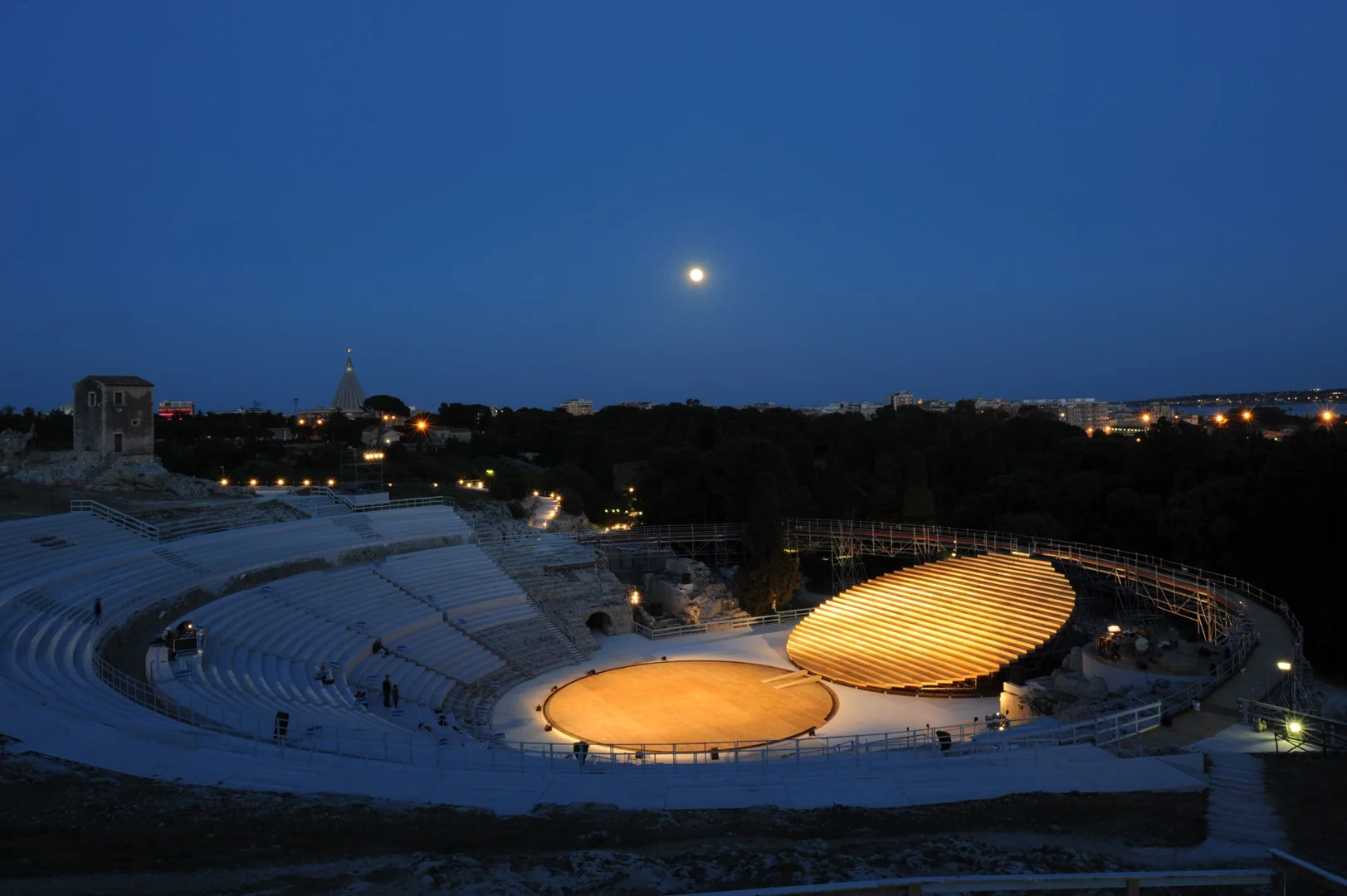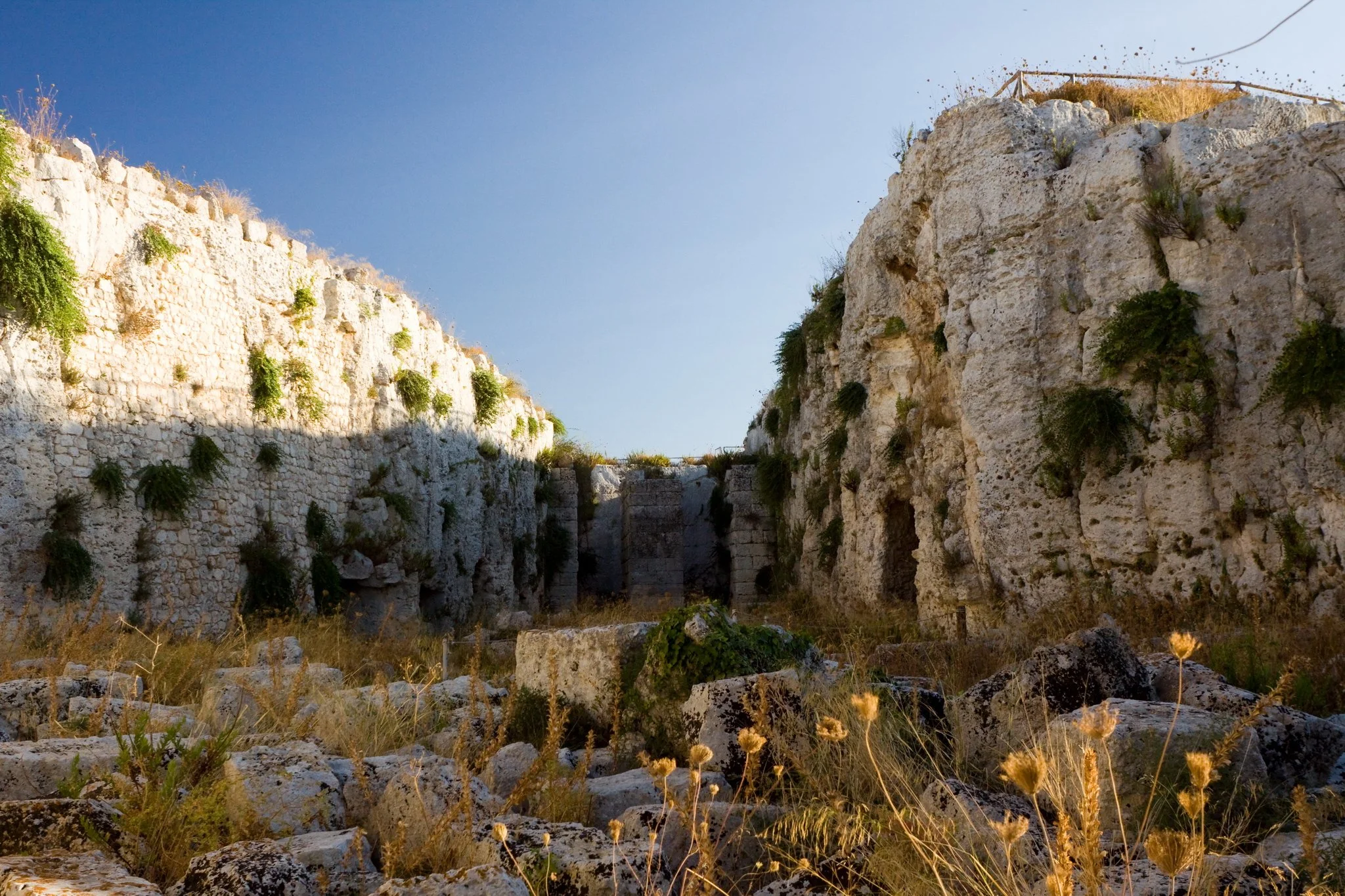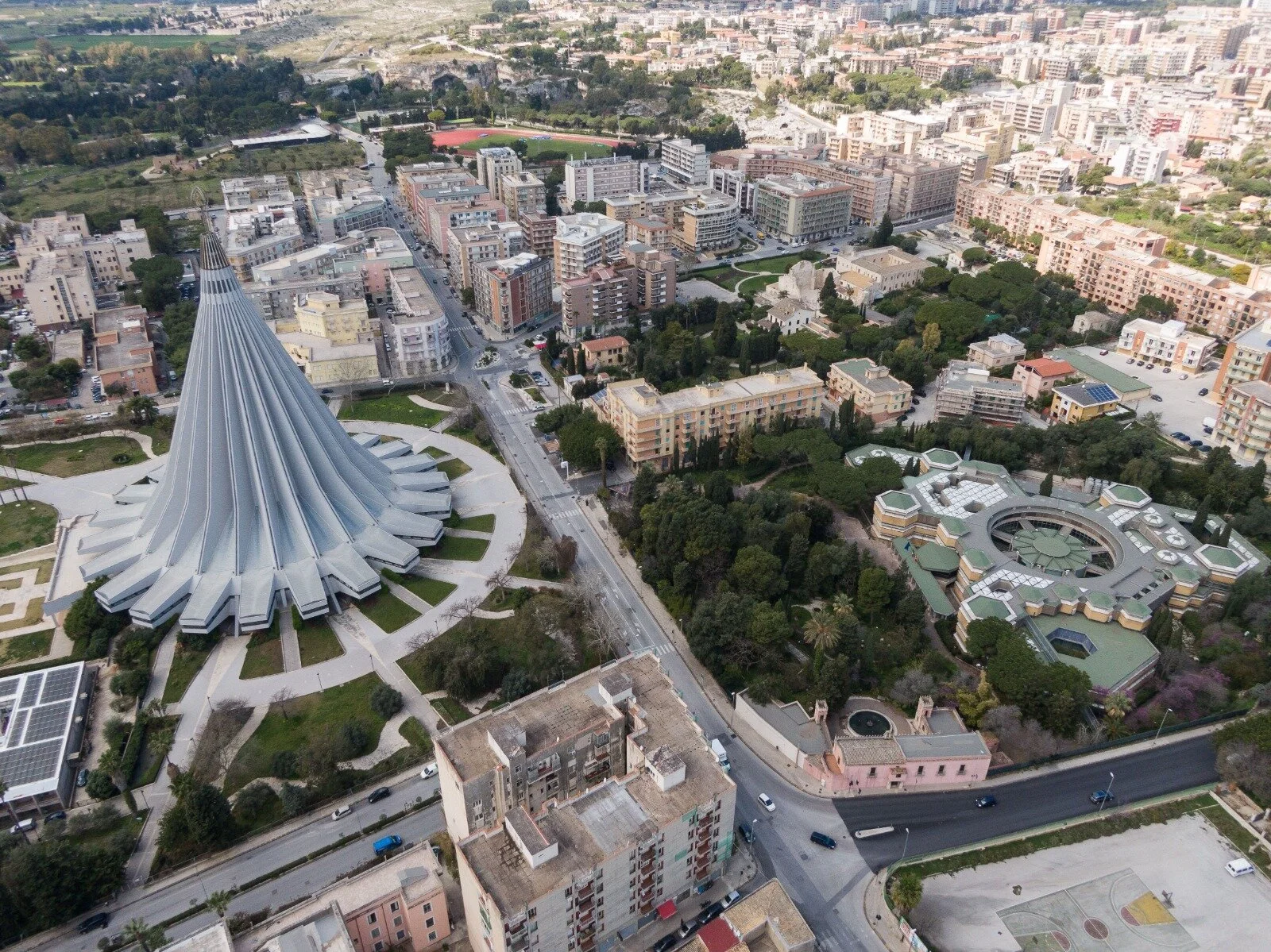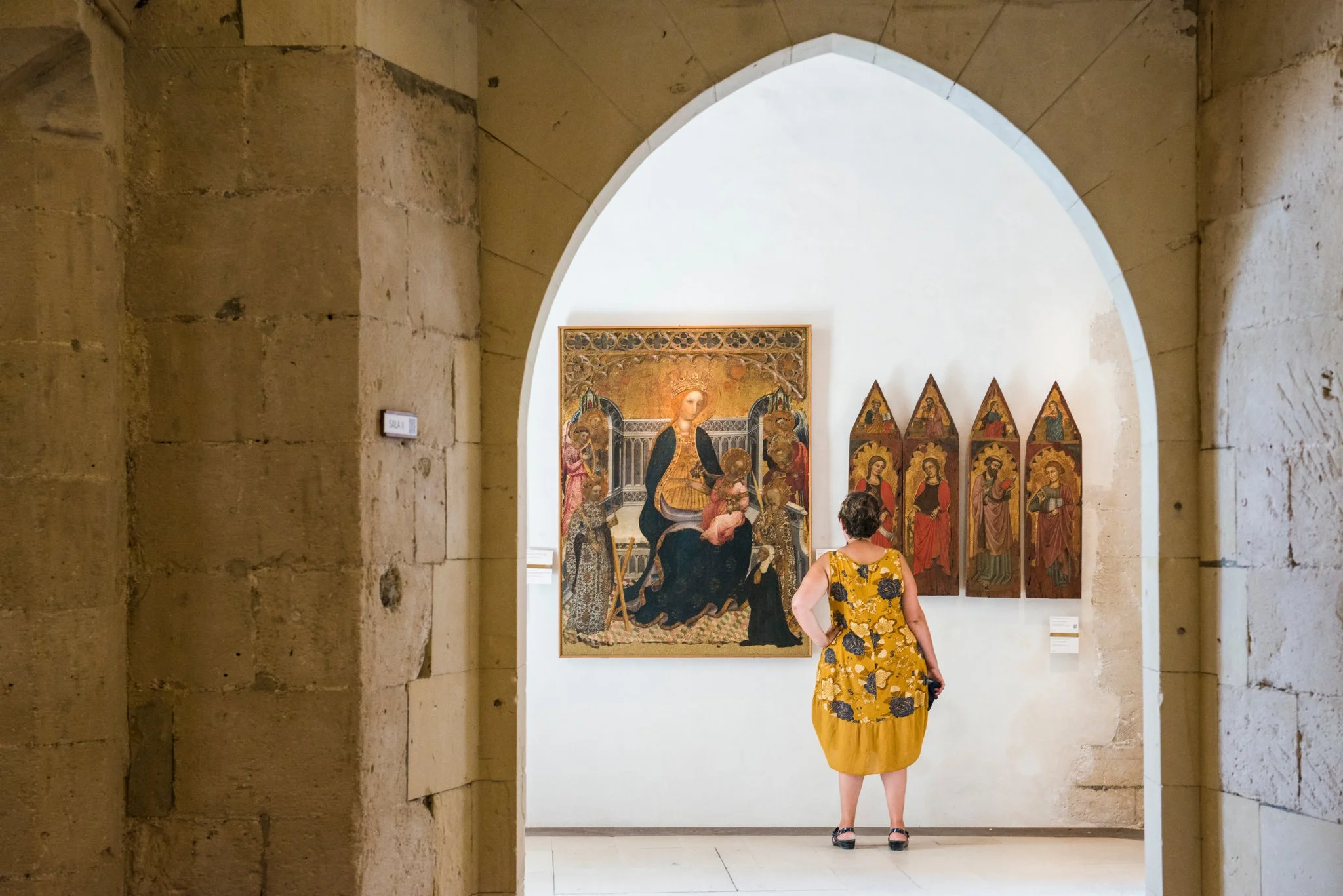What you can’t miss in Syracuse
Piazza Duomo & the Cathedral
Syracuse's showpiece square is a masterpiece in baroque town planning. A long, semi-elliptical piazza flanked by flamboyant palazzi, it sits on what was once Syracuse's ancient acropolis (fortified citadel). Across the stately Piazza del Duomo stands the cathedral (admission 2 euros), whose architecture and design elements form a survey of Syracuse’s history, from the ornately chiseled facade (Baroque) to the kaleidoscopic marble floor (Renaissance) to the soaring stone pillars integrated into the walls (remnants of a 480 B.C. temple to Athena).
Archeological Park
For the classicist, Syracuse's real attraction is this archaeological park, with its pearly white 5th-century-BC Teatro Greco . Hewn out of the rocky hillside, this 16,000-capacity amphitheatre staged the last tragedies of Aeschylus (including The Persians ), which were first performed here in his presence. In late spring it's brought to life with an annual season of classical theatre. Particularly stunning is the Ear of Dionysus, a soaring jagged cavern on a cathedral scale that amplifies even the tiniest noises into eerie echoes.
Back outside this area you'll find the entrance to the 2nd-century Anfiteatro Romano , originally used for gladiatorial combats and horse races. Admission 10 euros.
Street Market
Sicily’s horn of plenty spills out in a tide of colors, shapes and smells at Ortigia’s outdoor market. Walking down the lively, crowded corridor of storefronts, stalls and sidewalk tables, you get a vocabulary lesson and gastronomic tour all in one: purple-green carciofi (artichokes), orange zucche (pumpkins), brown mandorle(almonds), black barrette di cioccolato (chocolate bars) from Modica. But mostly you find freshly hooked and netted fish, including seppie (cuttlefish) and shiny green-black sgombro (mackerel). Breads, nuts, spices and cheeses round out the mix. Around the corner, a trinket market awaits for anyone intent on taking home a Vespa-shaped magnet or “Godfather” T-shirt.
Apollo Temple
Temple of Apollo in Syracuse is the oldest known Doric temple outside of Greece. Built in the early 6th century BCE, it pre-dates many similar structures in Magna Graecia and stands as one of the earliest examples of Greek architectural influence in the Western Mediterranean.
Originally dedicated to the god Apollo, the temple underwent several transformations over the centuries: it was converted into a Christian church during the Byzantine era, then a mosque under Arab rule, and later returned to a church in the Norman period. Today, although only a few columns and parts of the original structure remain, the site retains a historical and symbolic allure, reflecting the complex history of Syracuse and the cultural influences that shaped it.
Latomie dei Cappuccini
In February 2024 will be open every Sunday (Please ask us for updated open time, Don’t miss it! is an amazing place). The contrast between the idyllic beauty of the garden, created by the Capuchin monks in this former quarry, and the dizzyingly sheer cliffs that surround it, has fascinated visitors to this site for centuries, to the point that it was included as "must see" of the "Grand Tour" in Italy. Additionally, this quarry started as a stone quarry, but aside from signs of human activity also shows signs of the force of nature, including earthquakes, landslides, and erosion, in addition to an explosion of lush greenery, giving this site a rather "wild" and sometimes "lunar" appearance that cannot fail to strike the imagination. There are also two breathtaking open air theaters that animates the "movida" of the summer nights
Catacombs of St. John
Second biggest catacombs of the world a block north of the archaeological museum, this vast labyrinth of 10,000 underground tombs dates back to Roman times. A 30-minute guided tour ushers visitors through the catacombs as well as the atmospheric ruins of the Basilica di San Giovanni , Syracuse's earliest cathedral. The underground chapel is considered the first church in Europe and probably founded by St. Paul himself before arriving to Rome
Euryalus Castle
(They change quite often the schedule, please check before go. in June 2023: Open only on Wednesday morning 9.00-13.00 and Saturday afternoon 14.00-19.30) Don’t miss it, is somehow abandoned, but amazing!
Euryalus Fortress (the name comes from a Greek word, eyryélos, which means "shaped like a nail") of Syracuse is the largest castle dating back to Greek times that survives until the present day and one of the most important Greek monuments in Sicily. The Fort was built by Dionysius the Elder in six years, between 402 and 397 B.C., a time during which Syracuse was preparing for the inevitable clash with the Carthaginians for control of eastern Sicily. You will get lost in the excavated tunnels underground and immagine yourself in the ancient greek time. The view is of the area is great (from here is visible half Sicily, including Etna and Italy)
Maniace Castle
Guarding the island's southern tip, Ortygia's 13th-century castle is a lovely place to wander, gaze out over the water and contemplate Syracuse's past glories. It also houses occasional rotating exhibitions.
Burial of St. Lucy by Caravaggio
Is a painting by the Italian artist Caravaggio. It is located in the church of Santa Lucia in the Borgata neighborhood, at few steps from Ortigia. Caravaggio had escaped from prison on Malta in 1608, fleeing to Syracuse. There, his Roman companion Mario Minniti helped him get a commission for the present altarpiece. Caravaggio painted it in 1608, for the Franciscan church of Santa Lucia al Sepolcro. The choice of subject was driven by the fact that St. Lucy was the patron saint of Syracuse and had been interred below the church.
Dominated by somber blacks and browns, the canvas depicts the corpse of Syracuse’s patron saint (the only horizontal element) mourned by a priest in a blood-red scarf (the only splash of bright color) and a crowd of onlookers.
Our Lady of Tears Sanctuary
Designed to evoke a gigantic teardrop and at the same time a tent for the Pilgrims. The Shrine was designed by two French Radical Architects, Michel Arnault and Pierre Parat in 1966 and finally built in 1994. It houses a small statue of the Madonna that miraculously wept for 3 days in 1953. Alleged chemical tests showed that the liquid was similar to that of human tears. Pilgrims still flock here. The contemporary conical structure dominates the skyline, rising 74m (243 ft.) with a diameter of 80m (262 ft.). The concrete structure dome is spectacular from inside and You might get dizzy looking up at the vertical windows stretching skyward to the apex of the roof.
Archeological Museum Paolo Orsi
Don’t miss it! About 500m east of the archaeological park, this modern museum contains one of Italy's largest and most interesting archaeological collections. Allow plenty of time to investigate the four sectors charting the area's pre-history, as well as Syracuse's development from foundation to the late Roman period. All of the favorite Greco-Roman deities, heroes and creatures are there, in ceramic or sculptural form. Hercules drives chariots and fights lions on black-glazed pottery. A grinning satyr sails on a bloated wineskin. The early Christian relics are no less impressive, notably the Sarcophagus of Adelphia, which was discovered in the nearby catacombs of St. Giovanni. Dating to the 4th century, the funerary masterwork is chiseled with 13 biblical scenes — including the temptation of Adam and Eve, and the wedding at Cana — in three-dimensional reliefs. Admission 8 euros.
Pantalica
The Necropolis of Pantalica in southeast Sicily, Italy, is a collection of cemeteries with rock-cut chamber tombs dating from the 7th to the 13th centuries BC. There have been thought to be over 5000 tombs. They extend around the flanks of a large promontory located at the junction of the Anapo river with its tributary, the Calcinara, about 23 kilometres northwest of Syracuse.
Galleria Regionale Palazzo Bellomo
The number of Madonnas per square yard in the Galleria Regionale di Palazzo Bellomo — dedicated mostly to medieval, Renaissance and Baroque art — must surely approach record status. There she is, alongside her child, towering over a church carried by angels, in a surreal 1507 century painting by Alessandro Padovano and Giovanni Maria Trevisiano. There she is in Gothic mode, resplendent in deep reds, blues and golds, on a time-fissured wooden board by the Master of the Polyptych of Santa Maria. But certainly her most stunning rendition comes from the hand of Antonello da Messina. His 15th-century painting “Annunciation,” depicting Mary visited by an angel, is a masterwork of powerful color, exquisite detail and beatific light.
Pista ciclabile
Is a former rail track in disuse in the North of Syracuse, recently transformed in a Linear Park along the sea. Is also an open air sculpture museum park and has some access to the beach (Solarium Ru Frati) during summer time. Very much enjoyable in the early morning or just before the sunset.
Jewish Miqweh
The Jewish bath, the center of Jewish spiritual life, testifies to the existence of a Jewish community of Syracuse among the oldest in the Mediterranean. The miqweh, located 18 meters below street level, in the basement of a patrician building and fed by pure spring water, is one of the only ritual baths in Europe which still retains its integrity and its charm. The Jewish community of Syracuse used to bathe in the waters of miqwehs to “clear their sins”.
Teatro Massimo
A small gem of Ortigia for theater lovers, the Theater was built in 1872 by engineer Breda, replacing a church, monastery, and palace. Initially halted due to cracks, architect Damiani D’Almeyda took over, modifying the design. The grand exterior featured a carriage portico and eagle motif. Inside, a spacious foyer led to the stalls, boxes, and a large stage. The main curtain depicted Daphne, symbolizing bucolic poetry. Opened in 1897, the theater's brief sixty-year run ended in 1957 after notable performances.
Day Trips from Syracuse: Exploring Sicily Beyond the City
Syracuse is the perfect base for exploring southeastern Sicily, offering easy access to some of the island’s most stunning landscapes, historic towns, and cultural treasures. One of the best ways to experience the richness of Sicily is through day trips, or as Italians say, gite fuori porta. Just a short drive from Syracuse, you’ll find breathtaking landscapes, baroque treasures, and unique cultural experiences that make for unforgettable excursions. Here are six must-visit destinations outside the city.
Mount Etna: The Majestic Volcano
Towering over the island, Mount Etna is Europe’s highest and most active volcano. A visit here offers an incredible contrast between lush vineyards on its lower slopes and stark lunar landscapes higher up. Whether you choose to hike, take a cable car, or join a guided tour in a 4x4, the views from Etna’s summit are unparalleled. In winter, skiing on the volcano’s slopes is an unforgettable experience, while in warmer months, you can explore its craters and lava tunnels.
Modica: A Sweet Escape
Famous for its distinctive chocolate, Modica is a baroque jewel nestled among the hills of southeastern Sicily. Strolling through its narrow streets, you’ll be captivated by grand churches such as the Cathedral of San Giorgio and the town’s dramatic layout, built into the rock. Be sure to stop at a local chocolatier to taste the traditional cioccolato di Modica, made following ancient Aztec techniques brought to Sicily by the Spanish.
Ragusa: The Baroque Masterpiece
Divided into two parts—Ragusa Superiore and Ragusa Ibla—this city offers a fascinating journey through time. Ragusa Ibla, the historic lower town, is a labyrinth of elegant baroque palaces, charming piazzas, and the impressive Duomo di San Giorgio. Walking along the scenic stairways that connect the old and new towns provides stunning panoramic views. Ragusa is also a culinary paradise, with Michelin-starred restaurants serving exquisite interpretations of Sicilian cuisine.
Noto: The Pearl of Sicilian Baroque
Known as the capital of baroque, Noto is a UNESCO World Heritage site renowned for its harmonious architecture. As you walk along Corso Vittorio Emanuele, you’ll be mesmerized by golden-hued buildings, intricate balconies, and ornate facades. The grand Cathedral of San Nicolò, standing proudly at the heart of the town, is a masterpiece of baroque art. Visit Noto in spring for the Infiorata di Noto, a spectacular festival where artists create stunning floral mosaics along the streets.
Taormina: A Stunning Viewpoint
Though often considered a popular tourist destination, Taormina offers remarkable panoramic views. The ancient Greek Theatre is its true highlight, not only for its historical significance but for the breathtaking vista it provides over the sea and Mount Etna. From the town’s main square, Piazza IX Aprile, visitors can also admire a spectacular view of the Ionian Sea. While the town itself can feel somewhat crowded and overly polished, its natural setting remains undeniably beautiful.
Valley of the Temples: A Journey into Ancient Greece
Located in Agrigento, the Valley of the Temples is one of the most impressive archaeological sites in Sicily. This UNESCO World Heritage site features remarkably well-preserved Greek temples, including the stunning Temple of Concordia, which stands as one of the best-preserved Doric temples in the world. Walking among these ancient ruins, set against a backdrop of olive trees and rolling hills, offers a fascinating glimpse into Sicily’s rich classical heritage.
Each of these destinations offers a distinct glimpse into Sicily’s diverse landscapes and rich cultural heritage. Whether you’re drawn by nature, history, or food, these gite fuori porta will leave you with lasting memories of this enchanting island.

















